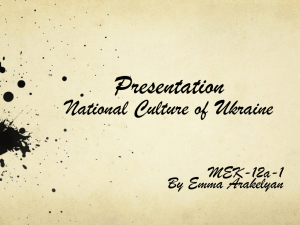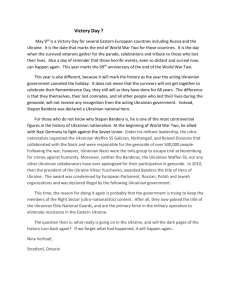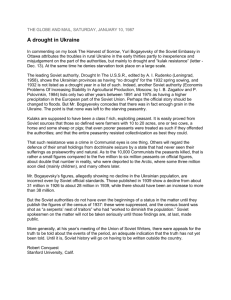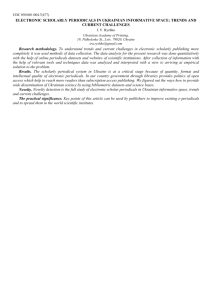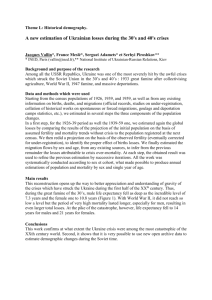Ukraine Under Stalin: Was the Great Famine a
advertisement
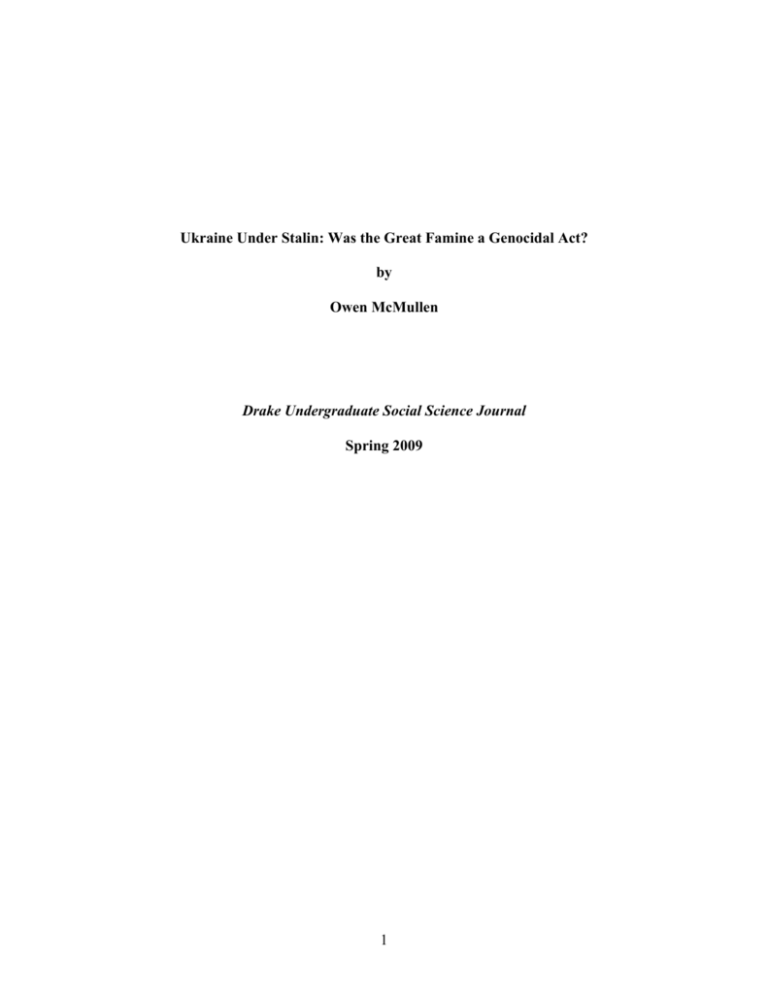
Ukraine Under Stalin: Was the Great Famine a Genocidal Act? by Owen McMullen Drake Undergraduate Social Science Journal Spring 2009 1 Ukraine under Stalin: Was the Great Famine a Genocidal act? The Ukraine Famine of the 1930s is one of the most horrific and under exposed acts of human suffering in the twentieth century. Ukraine, the breadbasket of the Soviet Union, had prospered during the 1920s under the Bukharin-backed New Economic Policy (NEP), resulting in a growth of nationalism. This prosperity was retarded with Stalin’s rise to power in the Soviet ranks, and his first Five Year Plan (implemented in 1928), both of which marked the beginning of the end of Ukraine’s prosperity. Over the next five years, through forced collectivization and exportation of grain, millions would perish through starvation and executions at the hands of the Soviet government. While independent factors added to the devastation, the initiation of the Soviet policy resulted in a government-induced famine that hit the Ukrainian people harder than any other ethnic group and should be assessed as genocide. In this essay I will explore the events leading up to the Great Famine, including Ukraine’s growth in national consciousness as well as the political and economic climate prior to the famine. The next section will chronicle in detail the horrors of the famine, examining Soviet policy and the estimated death toll. Additionally, I examine the question of whether these acts constitute genocide, by citing arguments for and against this classification. Finally, I will look at the impact of the Holodomor (Ukrainian term for the famine/genocide) on Ukrainian society and the political aftershock that are both still dominant to this day. Ukrainization and Growth during the 1920s Ukraine did not exist as a nation state prior the First World War; rather, ethnic Ukrainians were dispersed in the Russian and Austro-Hungarian Empires, as well as pockets in Poland and Romania. The Ukrainian language and culture was largely 2 suppressed in these foreign lands and thus a national identity failed to coalesce. Noted Soviet historian John Reshetar claims, “Contacts with the West were limited, and this seriously retarded the growth of national consciousness. It also meant that the economy of the territory remained predominantly agrarian even into the twentieth century. As a result Ukraine lacked a substantial middle class despite the substantial economic development which occurred in the nineteenth century.”1 The Russian Revolution in 1917 and the end of the Great War a year later, helped transform Ukrainian society. Russia’s turmoil during the Civil War spread to Ukraine, with factions divided between White Nationalists, Bolsheviks and Mensheviks. However, by 1922 with the war settled, and subsequent introduction of the NEP, Ukrainian culture thrived. “Following on a decree of August 1923, ‘Ukrainization’ of many aspects of life was pursued so long as it did not conflict with the political settlement of 1922. The Ukrainian language was introduced in all schools and in many more newspapers. Nationalist literary groups flourished, and the Ukrainian church took a new lease on life.”2 Cultural freedom was not the only aspect to burgeon during the NEP years, as Ukraine, like much of the rest of the USSR benefited economically during this time. Already considered the “breadbasket” of the Russian Empire during the Czarist years, the NEP only helped enhance this status. Thus by 1930, Ukrainians had reestablished their cultural heritage through these new programs and had finally been able to offer alternatives to Russian influences which had been so dominant in the past. Additionally, a growing Ukrainian intelligentsia looked to grant more autonomy from the Russian-dominated Ukrainian SSR. 1 John S. Reshetar Jr., The Ukraine Revolution, 1917-1920: A Study in Nationalism, (Princeton: Princeton University Press, 1952,) 319. 2 Roger Pethybridge, One Step Backwards, Two Steps Forward: Soviet Society and Politics under the New Economic Policy, (Oxford: Clarendon Press, 1990,) 258 3 Holodomor The causes of the Ukrainian Famine, much like the death toll and aftermath, remain murky and multifaceted. However, the three most prominent features included the forced collectivization, retreat from the Ukrainization policy, and the increased exportation of grains to the West during the early 1930s. Starting in 1929, Ukraine began to collectivize, much like the rest of the Soviet Union under Stalin’s new policy. Peasants’ land holdings were seized, along with their crops and livestock and Ukrainians were forced onto collective farms. The slaughter and destruction of their animals and grain became common, as many would rather sacrifice their animals rather than handing them over to the cruel People’s Commissariat for Internal Affairs (NKVD). The collectivization was the first step in establishing the conditions for the famine. In an attempt to find more enemies for the class struggle, Soviet forces looked to eliminate the “kulaks,” a vague class which was attacked to establish a more egalitarian society. This class had no fixed definition but the creation of this enemy gave NKVD agents carte blanche when dealing with peasants. In a review of Robert Conquest’s book “Harvest of Sorrows,” Eugene Methvin writes, The Stalinists resurrected the pejorative label "kulak," which translates roughly into "shylock" and had applied to wealthier peasants in czarist times who lent money to needier farmers. Applied to the Russian countryside of 1929, this was a joke. The most prosperous peasants had at most two or three cows and 25 acres for an average family of seven, and earned only about 50 percent more per capita than the poorest. They accounted for maybe 5 per cent of the peasant households and produced 20 percent of the grain, Conquest estimates.3 This attack on the kulaks particularly hurt Ukraine. Prosperous economic conditions under the NEP as well as the traditional natural resources of grain and agriculture meant 3 Eugene H Methvin, “Harvest of Sorrow: Soviet Collectivization and the Terror-Famine-Book Reviews.” National Review December 11th, 1995: 66 4 Ukraine had a large proportion of kulaks in propitiation to Russia and the rest of the Soviet Union. As a result, thousands were executed by the Soviet secret police. The collectivization of farms and the elimination of kulaks set the tone for what was to come. Stalin now looked to undo much of the progress the Ukrainization policy had achieved. “The radical phase of nationality policy came to an end in December 1932…Agents of Stalin traveled to the national areas and reported back that resistance to the agrarian revolution was linked to local nationalism. Tens of thousands of people were deported from their home villages, and tens of thousand of others were sent to prisons or forced labor camps.”4 Ukrainian newspapers were shut down, Russian was the only language taught in schools, and those who voiced nationalistic opinions were dealt with harshly. All these factors set the stage for the events of 1932-3, the high point of the famine. Firstly, weather conditions did contribute to poor harvests in the early 1930s. Official Soviet data lists that the sown area in Ukraine decreased from 21.2 million hectares in 1931 to 18.1 in 1932. Additionally, in terms of actual production, levels dropped from 18.3 to 14.6 between these two years.5 The lower grain harvest during this time was exasperated by Soviet policy. Despite the decrease in harvest output in 1932, the government called for an increase in grain procurements by a “figure that would have equaled just over half the Ukrainian harvest.”6 This marked an exponential increase in grain collection from about one third of its harvest being taken in 1930 to over half in 1932. The effects of this were staggering. With Soviet agents forcibly collecting grain 4 Ronald Grigor Suny, The Soviet Experiment: Russia, the USSR and the Successor States, (Oxford: Oxford University Press, 1998,) 286. 5 Mark B. Tauger, “The 1932 Harvest and the Famine of 1933,” Slavic Review 50 no. 1 (1991):72. 6 Suny, The Soviet Experiment: Russia, the USSR and the Successor State, 227. 5 and food from the Ukrainian collectivized farms, mass starvation became rampant. “Twice a month, Marxist brigades scoured houses for hidden food. If a peasant looked healthy, the Communists searched harder. One Ukrainian returned to his village in 1933 after a year's absence and found it "almost extinct." His family lived on rabbits, bark, and grass, a brother told him, but when these gave out, "Mother says we should eat her if she dies.”7 The images seen from the affects of this policy were not unlike the Holocaust during Nazi Germany. Robert Conquest described the entire territory of Ukraine as “one vast Belsen,”8 and laments that “The last sacks of grain were taken from barns for export while famine raged. Butter was sent abroad while the Ukrainian infants were dying for lack of milk.”9 It was not uncommon to see piles of rotting corpses throughout the country, as photographs have revealed after the fall of the USSR. By the end of 1933 Soviet Policy had changed: “By mid-March grain collection had ended in the Ukraine, and by May the famine had dissipated. But not before an estimated 5 million people died. Many Ukrainians, particularly outside the USSR, as well as some historians have argued that the famine of 1932 was the result of a deliberate policy of genocide aimed at eradicating Ukrainian nationalism.”10 Death Toll and Aftermath The death toll from this period is also hotly contested and estimates vary along the political spectrum. Robert Grigor Suny, a politically moderate historian, cites five million dead as his estimation. Conquest, in his novel the “Harvest of Sorrow,” comes up with 7 Lewis Lord, “A reign of rural terror, a world away,” U.S. News & World Report 134, no. 23 (2003): 58. Methvin, “Harvest of Sorrow: Soviet Collectivization and the Terror-Famine-Book Reviews,” 68. 9 Robert Conquest, Stalin’s Purge of the Thirties, (Harmondsworth: Penguin Books Ltd, 1968,) 45. 10 Suny, The Soviet Experiment: Russia, the USSR and the Successor State, 228. 8 6 the number of eight million dying as a result of the famine.11 He also notes “Even on official figures, the Ukraine’s population had sunk from 31 million to 28 million between 1926 and 1939. Even higher estimates are said to be given by Skrypnik and Balitsky to an American Communist.”12 Despite the opening of the vaults of Stalinist history, the official number will never be truly known. Future Soviet Premier Khrushchev even quipped, “No one was keeping count.”13 Unlike the Nazis, who kept meticulous records during the Holocaust, much of the killing was done by starvation rather than the gas chamber, thus further hindering efforts to reach an official death toll. Regardless of the official number, today it is universally held that millions of Ukrainians died from hunger related deaths during these two years. After the death of millions and the suppression of Ukrainian culture, anti-Soviet and anti-Russian sentiment grew during the 1930s and when Nazi Germany conquered the Ukrainian territory in 1941, many saw this as liberation. As a result, when many “Ukrainians chose to side with the Germans to fight against the Soviets, they acted in what they perceived to be their best interests, as have other nations in similar circumstances.”14 Sadly, much like the rest of Europe under Nazi control, many Ukrainians (with a history of anti-Semitism) collaborated with the Nazis in their attempt to eradicate the Jews. However, Boshyk notes that “yet in the midst of this inferno there were men and women who risked the lives of their families to save the Jews. The precise 11 Lord, “A reign of rural terror, a world away,” U.S. News & World Report 59. Conquest, Stalin’s Purge of the Thirties, 46. 13 Robert Conquest, Harvest of Sorrow: Soviet Collectivization and the Terror-Famine, (New York, Oxford University Press, 1987, ) 234. 14 Yury Boshyk, Ukraine during World War II: History and its Aftermath, (Alberta: Canadian Institute of Ukrainian Studies, 1986,) 13. 12 7 number shall probably never be known because most records note those who were discovered and executed by the Germans.”15 Famine, not Genocide The question of whether or not the famine was a genocidal act garners much debate. During the Cold War, many proponents of the Soviet Union or communism downplayed or ignored the famine; likewise, many pro-Western forces looked to play up the event to demonize the Soviet system. With the end of the Cold War and the opening of previously closed historical archives, it is now possible to examine both arguments. Various reasons are cited in claiming that the Holodomor was not genocide. Mark Tauger, writer for the Slavic Review Journal, argues that the poor harvest of 1932 was more prominent than previously thought when he states that “New Soviet archival data show that the 1932 harvest was much smaller than has been assumed and call for a revision of the genocide interpretation. The low 1932 harvest worsened severe food shortages already widespread in the Soviet Union at least since 1931 and, despite sharply reduced grain exports, made famine likely, if not inevitable in 1933.”16 Other arguments note that Ukraine was not the only region to suffer famine during this period and genocide must be an intentional action against a group of people. During this famine most of the victims were from the rural areas and not urban centers. For the term genocide to be accurate, detractors contest that all parts of Ukrainian society must have been affected and not just the peasant classes. Tauger also attempts to disprove the increase in procurement argument by stating that, “the 1932 grain procurement quota, and 15 16 Boshyk, Ukraine during World War II: History and its Aftermath, 47. Tauger, “The 1932 Harvest and the Famine of 1933,” 74. 8 the amount of actual grain collected was actually much smaller than those of any other year in the 1930s.”17 Finally, the fact that the policy was stopped by 1933 indicates that the intentions were not that of genocide, for if it was, then surely the policy would have continued well into the 1930s. Genocide, not Famine I will begin my argument by refuting the above claims of why the famine was not genocide. Firstly, in response to Tauger’s points on the effects of the harvest and the Soviet procurements, the data he presents are unreliable. The chief diagram he uses to list the procurement and harvest output was taken from official Soviet archives, which are tainted since several of the categories listed are left blank in some years and in other instances no data is provided at all. Even if these documents were more inclusive, they do not account for the massive death toll that the writer himself does not dispute. The arguments that the famine could not be considered genocide as it only affected the rural population in Ukraine and was widespread throughout the USSR are both false and insubstantial. Yaroslav Bilinsky wrote in the Journal of Genocide Research, “Not only was collectivization pushed faster and more ruthlessly in Ukraine than in Russia, in Ukraine it was linked to the persecution of Ukrainian elites.”18 Additionally, while the famine affected the rural population more than the urban, the NKVD executed and imprisoned thousands of urban-dwelling Ukrainian intellectuals and nationalists. The fact that famines were widespread among other minority groups in the 17 Tauger, “The 1932 Harvest and the Famine of 1933,” 72. Yaroslav Bilinsky, “Was the Ukrainian Famine of 1932-1933 genocide?” Journal of Genocide Research 1 no. 2 (1999): 150. 18 9 USSR only buttresses the idea that the Soviets had a genocidal agenda against ethnic minorities. Robert Conquest places the blame solely on the Soviet regime, stating that “The famine can be blamed quite flatly on Stalin. The crop of 1932 was about 12 percent bellow average. This was far from being famine level. But procurements of food from the peasantry were up by 44 percent. The result was, and could not have been other than, large-scale starvation. It is perhaps the only case in history of purely man made famine.”19 Additionally, primary documents, which unlike the unreliable numbers taken in chaotic grain procurements, show intent of elimination. Note this document from the Politburo: To place the following villages on the black list for overt disruption of the grain collection plan and for malicious sabotage, organized by kulak and counterrevolutionary elements: 1. village of Verbka in Pavlograd raion, Dnepropetrovsk oblast. ... 5. village of Sviatotroitskoe in Troitsk raion, Odessa oblast. 6. village of Peski in Bashtan raion, Odessa oblast. The following measures should be undertaken with respect to these villages: 1. Immediate cessation of delivery of goods, complete suspension of cooperative and state trade in the villages, and removal of all available goods from cooperative and state stores. 2. Full prohibition of collective farm trade for both collective farms and collective farmers, and for private farmers. 3. Cessation of any sort of credit and demand for early repayment of credit and other financial obligations. 4. Investigation and purge of all sorts of foreign and hostile elements from cooperative and state institutions, to be carried out by organs of the Workers and Peasants Inspectorate. 5. Investigation and purge of collective farms in these villages, with removal of counterrevolutionary elements and organizers of grain collection disruption.20 19 Conquest, Stalin’s Purge of the Thirties, 45. United States of America, Library of Congress Online, “Addendum to the minutes of Politburo [meeting] No. 93.” 20 10 This death sentence is but a token of the horrors millions had to endure for showing “kulak and counterrevolutionary elements.” Political scientist Henry Huttenbach defines genocide this way: it is “the destruction of a specific group within a given national or even international population…Genocide is any act that puts the existence of a group in jeopardy.”21 Given this definition, the Ukrainian Famine can be deemed genocide. Bilinsky agrees, “I believe the famine fits the somewhat loose UN Genocide Convention…The famine would also fit the narrower definition of Huttenbach.” 22 Lasting Impact The Holodomor remains a contentious issue in the Ukraine and around the world. With the Soviet Union joining the Allies during the Second World War, the event was often covered up to defeat the greater threat of Fascism. “It has recently been established that Western governments were in possession of the facts about the famine, deliberately created by Stalin in 1932-3 (which claimed millions of Ukrainian lives) but chose not to protest for fear of harming their relations with the USSR.”23 As a result of its underexposure at the time, the Holodomor received little historical attention outside of Ukraine. With the end of the Cold War, this perception changed slightly and now several countries recognize the Great Famine as genocide.24 Russia is not one of those nations and has firmly rejected any notion of genocide. “In 2003 Russia's ambassador to Ukraine, Viktor Chernomyrdin, was quoted by Interfax news agency as dismissing talk of an 21 Bilinsky, “Was the Ukrainian Famine of 1932-1933 genocide?” 153. Bilinsky, “Was the Ukrainian Famine of 1932-1933 genocide?” 154. 23 Boshyk, Ukraine during World War II: History and its Aftermath, 56 24 “Ukraine demands 'genocide' marked.” BBC News. 22 11 apology or compensation, saying: "We're not going to apologize... there is nobody to apologise to.”25 Conclusion Regardless of political affiliation, all evidence suggests that the Great Famine of 1932-3 resulted in the death of millions of Ukrainians. While Ukrainians were not the only ethnic group to suffer under Stalin during the 1930s, they bore the brunt of his collectivization policy. By increasing grain procurements when such food was unavailable, exporting Ukrainian agriculture abroad while millions starved and sharply censoring Ukrainian culture, the Great Famine fits Huttenbach’s definition as “any act that puts the existence of a group in jeopardy.” Thus the Soviet’s man-made famine in the Ukraine should be recognized as genocide. Unfortunately, the politics of the matter make any universal international declaration unlikely and the victims of this tragedy remain disregarded. “History is replete with tragedy. For example during the artificial famine in Ukraine in the 1930s the Soviets forcibly exported food and prevented the importation of food; millions starved. Forgetting tragedy means forgetting history.”26 25 26 See Footnote 24 Boshyk, Ukraine during World War II: History and its Aftermath, 14 12 Bibliography Bilinsky, Yaroslav. “Was the Ukrainian Famine of 1932-1933 genocide?” Journal of Genocide Research 1 no. 2 (1999): 147-156. Boshyk, Yury. Ukraine during World War II: History and its Aftermath. Alberta: Canadian Institute of Ukrainian Studies, 1986. Conquest, Robert. Harvest of Sorrow: Soviet Collectivization and the Terror-Famine. New York, Oxford University Press, 1987. Conquest, Robert. Stalin’s Purge of the Thirties. Harmondsworth: Penguin Books Ltd, 1968. Lord, Lewis. “A reign of rural terror, a world away.” U.S. News & World Report 134, no. 23 (2003): 55-64. Accessed from Academic Search Premier. Methvin, Eugene H. “Harvest of Sorrow: Soviet Collectivization and the Terror-FamineBook Reviews.” National Review December 11th, 1995: 66-70. Accessed from Academic Search Premier Pethybridge, Roger. One Step Backwards, Two Steps Forward: Soviet Society and Politics under the New Economic Policy. Oxford: Clarendon Press, 1990. Reshetar Jr., John S. The Ukraine Revolution, 1917-1920: A Study in Nationalism. Princeton: Princeton University Press, 1952. Suny, Ronald Grigor. The Soviet Experiment: Russia, the USSR and the Successor States. Oxford: Oxford University Press, 1998. Tauger, Mark B. “The 1932 Harvest and the Famine of 1933.” Slavic Review 50 no. 1 (1991): 70-89. “Ukraine demands 'genocide' marked.” BBC News. http://news.bbc.co.uk/2/hi/europe/4471256.stm United States of America. Library of Congress Online. “Addendum to the minutes of Politburo [meeting] No. 93.” http://blackboard.elearning.uq.edu.au/webapps/portal/frameset.jsp?tab=courses &url=/bin/common/course.pl?course_id=_76245_1 13

